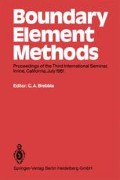Abstract
A new type of boundary element program is presented. The equations are derived by use of integral operators. A natural way of deducing element matrices in BEM is shown, which leads to a new technique for establishing the system of equations. A simple subsidiary condition technique, which makes it possible to take discontinous tractions into account, is presented. Guidelines are given for the BE-discretization and the numerical integration. Formulas for the analytical integration of the singular terms are shown. A non-conventional method for coupling BEM and FEM is proposed. Numerical studies have been made in order to investigate the performance of different elements.
Access this chapter
Tax calculation will be finalised at checkout
Purchases are for personal use only
Preview
Unable to display preview. Download preview PDF.
References
Alarcon, E., Martin, A., and Paris, F. (1979), Boundary elements in potential and elasticity theory, Computers and Structures, 10, pp. 351–362.
Banerjee, R.K. and Butterfield, R. (1979), Developments in Boundary Element Methods, Appl. Science Publishers Ltd, London.
Borowicka, H. (1939), Druckverteilung unter elastischen Platten, Ingenieur Archiv, vol. X, No. 2, pp. 113–125.
Brebbia, C.A. and Walker, S. (1980), Boundary element techniques in engineering, Newnes-Butterworths, London.
Hartmann, F. (1980), Computing the C-matrix in non-smooth boundary points, Proc. of the Second Int. Sem. on Recent Advances in Boundary Element Methods, held at Univ. of Sothampton, March 1980.
Jaswon, M.A. and Symm, G.T. (1977), Integral Equation Methods in Potential Theory and Elastostatics, Academic Press, New York.
Jeng, G and Wexler A (1977), Isoparametric, finite element variational solution of integral equations for three-dimensional fields, Int. J. for Numerical Methods in Eng., 11, pp. 1455–1471.
Kelly, D.W., Mustoe, G.W, and Zienkiewicz, O.C. (1979), Coupling Boundary Element Methods with Other Numerical Methods, Developments in Boundary Element Methods — 1 (editors: Banerjee and Butterfield), Appl. Science Publishers Ltd, London.
Nedelec, J.C. (1977), Cours de l’Ecole d’Ete’ d’Analyse Numerique, C.E.A., I.R.I.A., E.P.F.
Poulos and Davis (1974), Elastic solutions for soil and rock mechanics, John Wiley & Sons, New York.
Roark, R.S. (1965), Formulas for stress and strain, McGraw Hill, New York.
Watson, J.O. (1980), Advanced implementation of the boundary element method for two-and three-dimensional elastostatics, Developments in Boundary Element Methods — 1 (editors: Banerjee and Butterfield), Appl. Science Publishers Ltd, London.
Wendland, W.L., Stephan, E., and Hsiao, G.C. (1979), On the integral equation method for the plane mixed boundary value problem of the Laplacian, Math. Meth. in Appl. Sci., 1, pp. 265–321.
Wennerström and Petersson (1979), GENFEM-3, Verification Manual, Publ. 79:5, Dept of Structural Mechanics, Chalmers University of Technology, Göteborg, Sweden.
Author information
Authors and Affiliations
Editor information
Editors and Affiliations
Rights and permissions
Copyright information
© 1981 Springer-Verlag Berlin Heidelberg
About this paper
Cite this paper
Bolteus, L., Tullberg, O. (1981). BEMSTAT — A New Type of Boundary Element Program for Two-Dimensional Elasticity Problems. In: Brebbia, C.A. (eds) Boundary Element Methods. Boundary Elements, vol 3. Springer, Berlin, Heidelberg. https://doi.org/10.1007/978-3-662-11270-0_33
Download citation
DOI: https://doi.org/10.1007/978-3-662-11270-0_33
Publisher Name: Springer, Berlin, Heidelberg
Print ISBN: 978-3-662-11272-4
Online ISBN: 978-3-662-11270-0
eBook Packages: Springer Book Archive

